Success has its rewards, but like most drugs it also has its undesirable side-effects. Here in sunny Garden Amateurland, our modest success in growing things in all our lovely Australian sunshine is, ironically enough, lots more shade, and less sunshine.
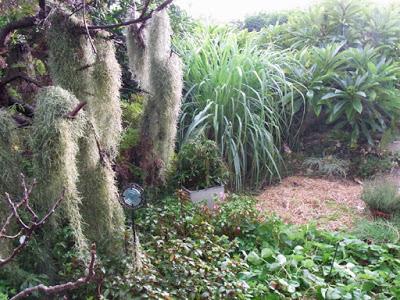
Avert your eyes from our captivating tresses of Spanish moss for a moment if you can, because in the background you can see our two major shade-makers. In the center is a lemongrass patch that has grown that big in one season, and on the right is our beautiful frangipani tree, which once was a cutting but is now approaching youthful adulthood. The little patch of straw mulch in front of both was once our garden's sunniest spot, a thriving little vegie patch, but right now it barely gets an hour of direct sunshine each day. It's overshadowed by success and I'm not sure what to grow there.

What to do with the lemongrass is a simple matter of cutting it back a month or two from now, in what was once known as "midwinter". I suspect we won't get much of a winter this year, if our warmest-ever autumn is any guide. However, the lemongrass will benefit from a very savage cutback, but will be this size again, same time next year. It's one of my favorite plants in the garden. It's very pleasantly lemony-scented to be near while I'm weeding, and its many graceful arches look like a green fireworks explosion frozen in time.
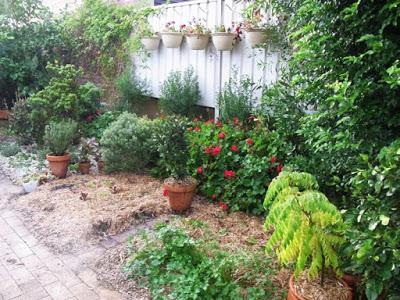
As a result of all this shade, I have swapped around the roles of a few garden beds. This is eastern side of the garden, now our sunniest spot.
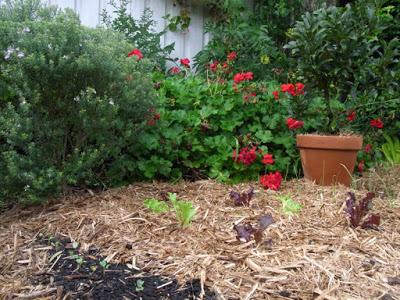
One little bed is now our salad patch. In the foreground, another row of radish seeds have just sprouted this morning (hello!), next to them some lettuce seedlings are doing their thing, and barely visible, slender baby shallots/scallions are making their usual hesitant start.
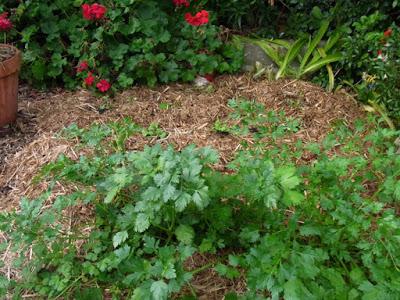
Next door to salad-land, in our other sunny spot, that's parsley in the foreground, grown from supermarket salad parsley 'micro-sprouts' (see this older post for more on that), and behind the parsley is Pammy's 2016 crop of Iceland poppies, something I grow for her every year.
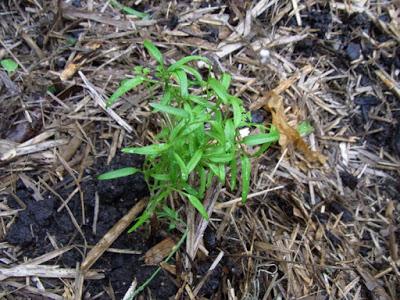
As for what to grow in the shadier spots, several different herbs do remarkably well in less than full sunshine. Here's some chervil supermarket mico-sprouts planted just yesterday. Chervil is a herb more people should grow and use in both cooking and salads, and it has the bonus that it is not only good in semi-shade (or semi-sunshine if you like), it actually seems to prefer the gloom. Parsley also copes fairly well with semi-shade, and as I've also planted a whole punnet of coriander micro-sprouts from the supermarket into the semi-shaded spot overshadowed by the lemongrass, I'll soon find out how it goes there.

As for what to do about our garden's major shade-maker, the frangipani tree, it's a conundrum. It's beautiful, and as you can see here it's not just beautiful on the outside, with its fragrant yellow-centred white blooms. Even on the "inside", the space under the frangipani is a deep-shade mini forest that has a touch of the fairytales about it. It does need to be trimmed a bit, but not too much.
In years gone by the deciduous frangipani would drop all its leaves in June and would only fire up again in greenery in late August. In our ever-warming climate I suspect it will be leafless for just a few weeks every year.
The frangipani is also spreading so wide it's actually growing over the path leading out to Pammy's art studio at the bottom of the garden, so a few branches will be removed in winter so she can get out there without being fragrantly whacked in the face next summer.
We haven't really made up our mind what to do about the frangipani. In the long run it will grow bigger and it will change how our garden grows. My instinct is to go with the flow and not to be too much "in charge" of everything that happens here. I'm just the gardener. While the odd bit of wayward frangipani might be lopped off, I suspect gardening here over coming years will take its own sweet-scented course.
